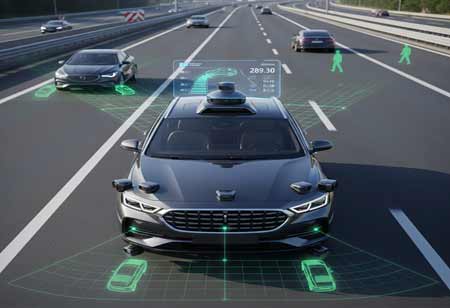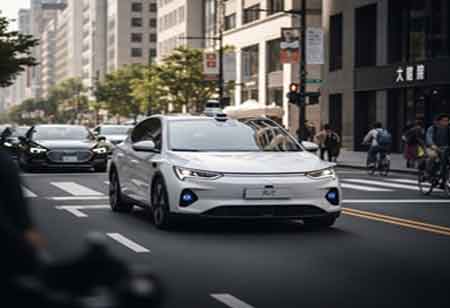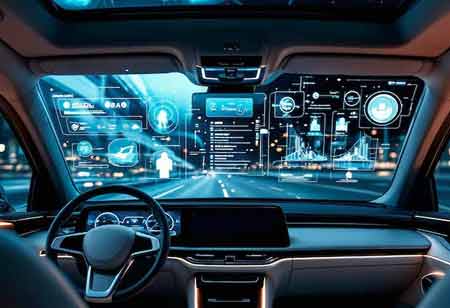THANK YOU FOR SUBSCRIBING
THANK YOU FOR SUBSCRIBING
Be first to read the latest tech news, Industry Leader's Insights, and CIO interviews of medium and large enterprises exclusively from Auto Tech Outlook

By
Auto Tech Outlook | Tuesday, October 28, 2025
Stay ahead of the industry with exclusive feature stories on the top companies, expert insights and the latest news delivered straight to your inbox. Subscribe today.
Autonomous vehicle safety systems have emerged as the foundation for advancing self-driving technology, serving as the enabler of innovation and the guardian of public trust. These systems integrate artificial intelligence, advanced sensors, and predictive decision-making tools to ensure that vehicles can navigate complex environments with precision and reliability. By prioritizing accident prevention and safeguarding passengers, pedestrians, and infrastructure, they address one of the most critical factors influencing widespread adoption of autonomous mobility.
Evolving Patterns in the Safety Landscape
Autonomous vehicle safety systems are rapidly redefining the mobility ecosystem, emerging as the cornerstone of trust and adoption in self-driving technologies. These systems combine advanced sensors, artificial intelligence, and real-time decision-making tools to safeguard passengers, pedestrians, and surrounding vehicles. The industry is witnessing an accelerated adoption of layered safety measures that blend perception technologies, connectivity, and predictive algorithms to reduce the likelihood of collisions. Stakeholders ranging from manufacturers to regulators emphasize rigorous safety benchmarks, ensuring that self-driving systems evolve beyond prototype functionality into everyday reliability.
Integration of multiple sensor modalities has become a defining feature of current market progress. Radar, lidar, and camera systems work together to build a redundant perception framework, enabling accurate object detection and situational awareness even under challenging conditions such as poor lighting or inclement weather. This redundancy ensures continuity of decision-making and limits the probability of system failure. Another prominent trend is the rise of vehicle-to-everything communication, where cars interact with one another and also with infrastructure and digital traffic management systems. This networked safety approach reduces blind spots, enhances traffic flow, and prevents incidents through predictive coordination.
Regulatory and standards-setting bodies are shaping harmonized safety frameworks that accelerate innovation while maintaining accountability. The industry is leaning toward global alignment of performance requirements to streamline testing and deployment across regions. This synchronization reduces fragmentation, providing manufacturers and suppliers a consistent pathway to market entry while reinforcing public confidence. With safety as the central pillar, these evolving patterns lay the groundwork for the sustainable adoption of autonomous vehicles at scale.
Barriers to Safety and Practical Resolutions
Despite significant progress, autonomous vehicle safety systems encounter persistent hurdles that require targeted remedies. One prominent challenge lies in edge-case detection, where unpredictable scenarios such as unusual pedestrian behavior or sudden roadway hazards can compromise safety. The solution to this issue lies in continuously exposing systems to diverse datasets, both simulated and real-world. High-fidelity digital twins and advanced scenario libraries enable training algorithms to anticipate rare but high-impact events, thereby enhancing adaptability without compromising public safety.
Another barrier arises from sensor limitations. Adverse conditions, such as heavy rain, snow, or fog, can impair visual systems, resulting in reduced situational awareness. To overcome this, safety frameworks employ sensor fusion strategies, combining complementary modalities to compensate for individual weaknesses. For example, while cameras struggle in low visibility, radar maintains accuracy, and lidar offers detailed depth perception. By layering these technologies and applying adaptive algorithms, the system sustains reliability across variable environments.
Cybersecurity concerns also pose a formidable challenge. As autonomous vehicles rely on interconnected networks, vulnerabilities can expose systems to malicious interference, potentially jeopardizing safety. Mitigation strategies include adopting end-to-end encryption, intrusion detection systems, and secure over-the-air updates that continuously patch weaknesses. Independent security audits and penetration testing provide further assurance, creating a resilient architecture resistant to evolving threats.
Ethical decision-making in unavoidable accident scenarios is another sensitive hurdle. Questions of prioritization, such as how systems should react when harm cannot be entirely prevented, require careful resolution. The practical approach involves embedding transparent ethical frameworks into programming, guided by multidisciplinary input from ethicists, policymakers, and engineers. These decisions are validated through transparent reporting mechanisms, ensuring accountability and fostering trust.
A further challenge lies in public perception and acceptance. Safety systems may demonstrate statistical superiority over human driving, yet skepticism persists. Addressing this involves transparent communication of performance data, public testing under controlled conditions, and education campaigns that highlight how autonomous systems reduce fatalities and injuries. Demonstrating consistent reliability in pilot deployments builds familiarity, gradually converting skepticism into trust.
The cost of integrating advanced safety technologies can burden manufacturers and delay mass adoption. Solutions include modular system design, scalable production, and partnerships with component suppliers that reduce cost per unit as production expands. Open-source safety frameworks and shared testing environments also reduce duplication of effort, enabling efficient innovation without compromising competitiveness.
Pathways of Innovation: Delivering Stakeholder Value
The sector is witnessing groundbreaking innovations that enhance the effectiveness of autonomous vehicle safety systems while delivering tangible value to stakeholders. Artificial intelligence advancements are enabling vehicles to transition from reactive responses to predictive capabilities. By analyzing traffic patterns, driver behavior, and environmental cues, systems can forecast potential hazards before they materialize. This proactive layer reduces collision risks and enhances passenger comfort by ensuring smoother driving maneuvers.
Advancements in real-time data processing are expanding the scope of safety. Edge computing ensures that decision-making occurs instantly within the vehicle, minimizing latency and dependency on external networks. This innovation is especially valuable in complex urban environments where rapid responses are crucial. The distributed computing approach also allows vehicles to maintain high safety standards even when connectivity is limited, enhancing reliability across diverse operating regions.
More in News
 Copyright © 2025 AutoTech Outlook. All Rights Reserved | Privacy Policy | White papers | Subscribe | Sitemap | About us | Feedback Policy | Editorial Policy
Copyright © 2025 AutoTech Outlook. All Rights Reserved | Privacy Policy | White papers | Subscribe | Sitemap | About us | Feedback Policy | Editorial Policy 



